Ever wondered how to shield your painted wood pieces from the ravages of the outdoors? Let’s uncover the secret together!”
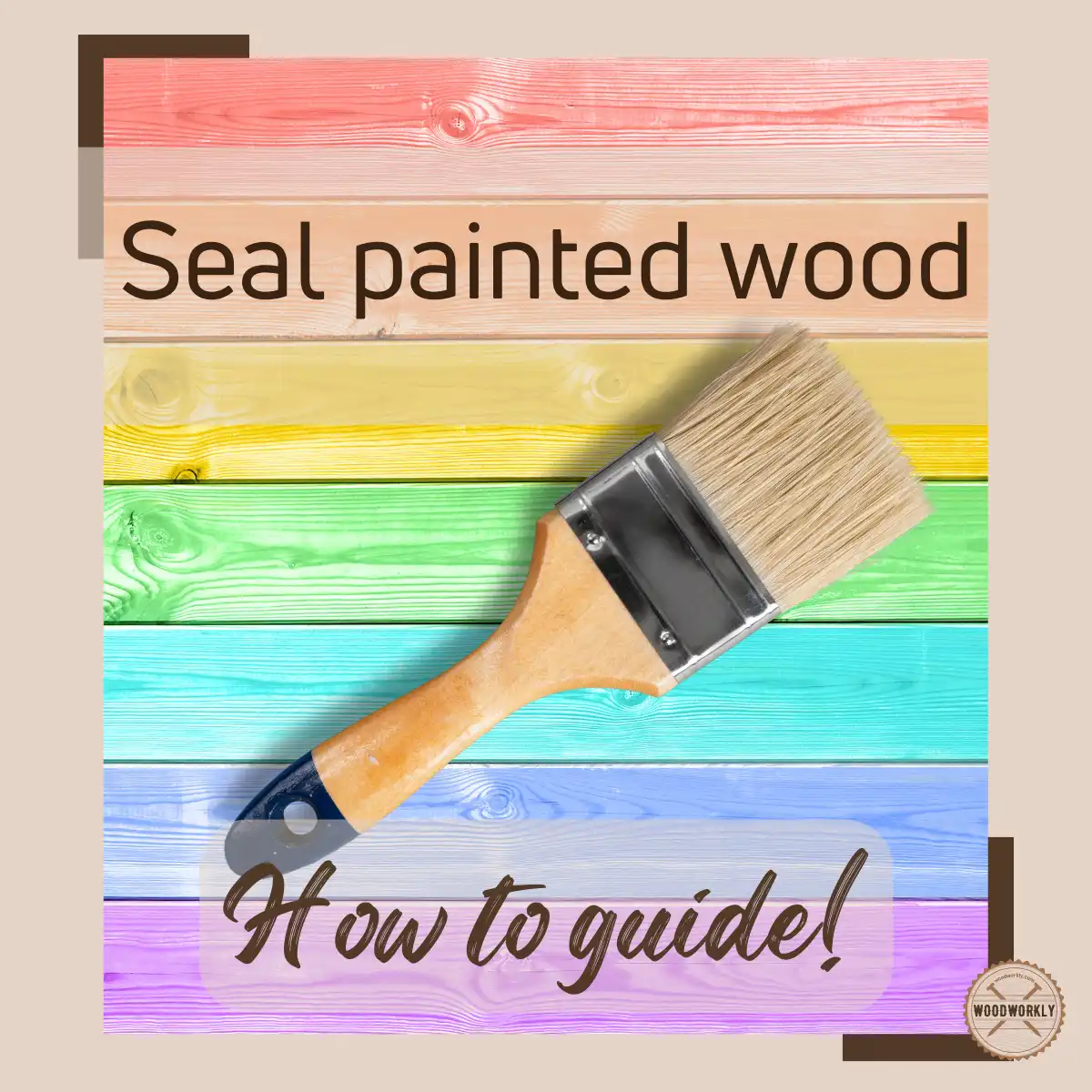
Surprisingly my mother’s precious outdoor furniture remains as it is even after several summer seasons!
Well…What can be the reason? Oh, I just remember. The secret is waterproofing after painting the wood for its long-lasting durability.
Proudly saying, this idea was mine. I did deep research on how to protect outdoor wood furniture from severe environmental effects.
Have you also been searching on how to protect your outdoor painted wooden items? Then, you are in the right place.
So, let’s find out How to seal painted wood for outdoor use?
To seal painted wood for outdoor use, clean the surface thoroughly and apply a compatible sealer like clear polyurethane or polycrylic. Choose the sealer based on the type of paint used (latex/acrylic or oil-based) to prevent flaking and prolong the life of the finish.
Not only that. There’s a lot to know.

In this article, I’ll dive deep into how to seal painted wood for outdoor use using proper techniques and I’ll include my personal experience and experts’ opinions as well to provide you awesome results in the end.
So, let’s dive in!

What are Wood Paints and Sealants?
Wood paints are a type of paint specifically designed for use on wooden surfaces. It has both ornamental and protective properties.
The paint contains compounds that improve the overall appearance of wood while also protecting it from environmental causes such as moisture, mold growth, rot, stains, and photodegradation caused by sunshine.
Wood paints are available in a variety of colors and types each suited for a specific use and desired finish.
Sealants are used to seal or close gaps, joints, or surfaces to prevent air, water, dust, or other impurities from passing through the surface applied.
These are often applied as a liquid or paste, hardening or curing to produce a flexible, protective barrier.
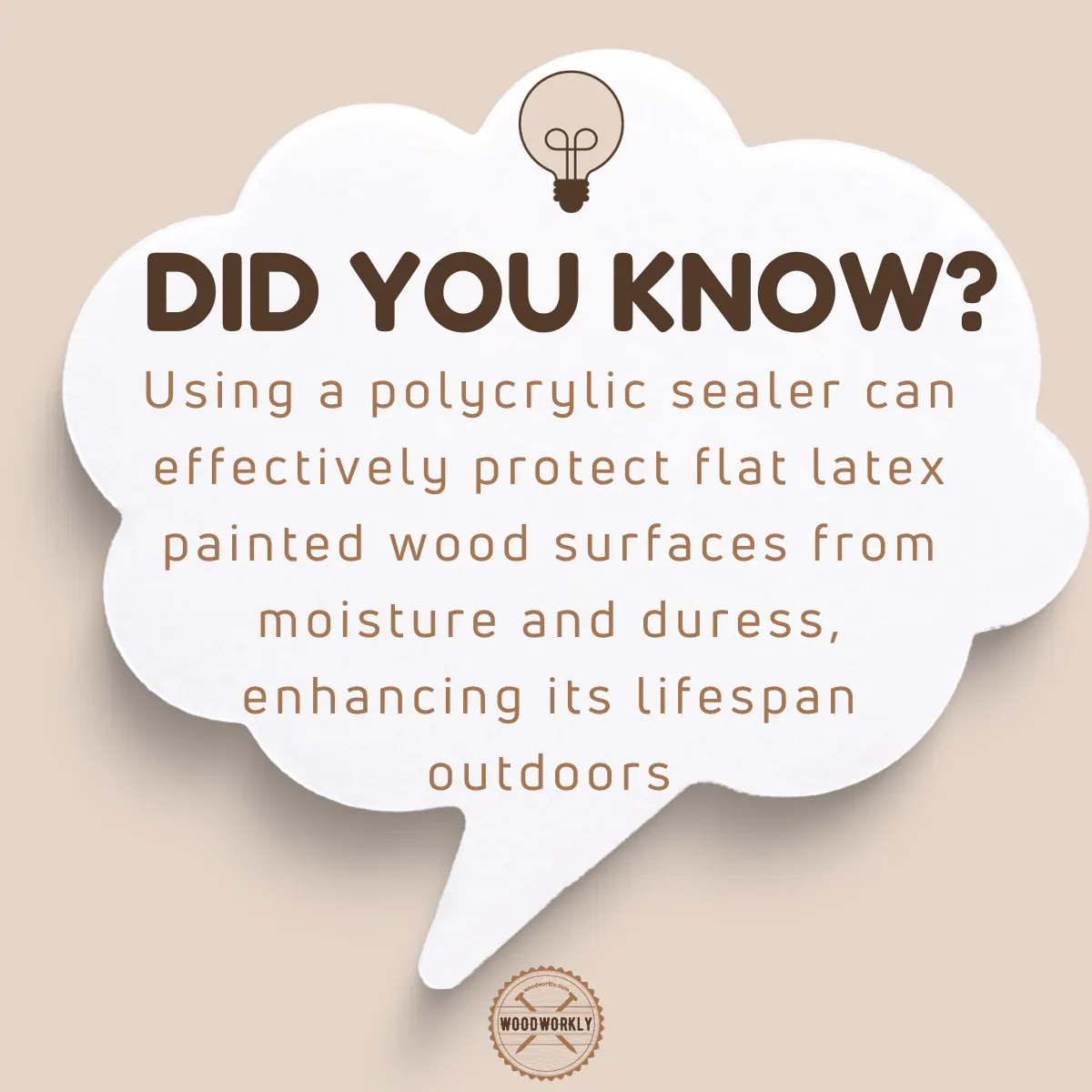
Is Sealing Essential for Painted Woods?
No. The sealing isn’t essential if you use exterior-grade paint.
Exterior paints have been designed as they can withstand environmental conditions such as rain, snow, sunlight, and temperature fluctuations.
Some exterior paints contain ingredients that can provide UV resistivity in order to prevent the shading of the color of the paint.
You just need to apply two or three coats of exterior grade paint instead of applying a separate sealer.
However, there are some circumstances in which sealing is important over painted wood.
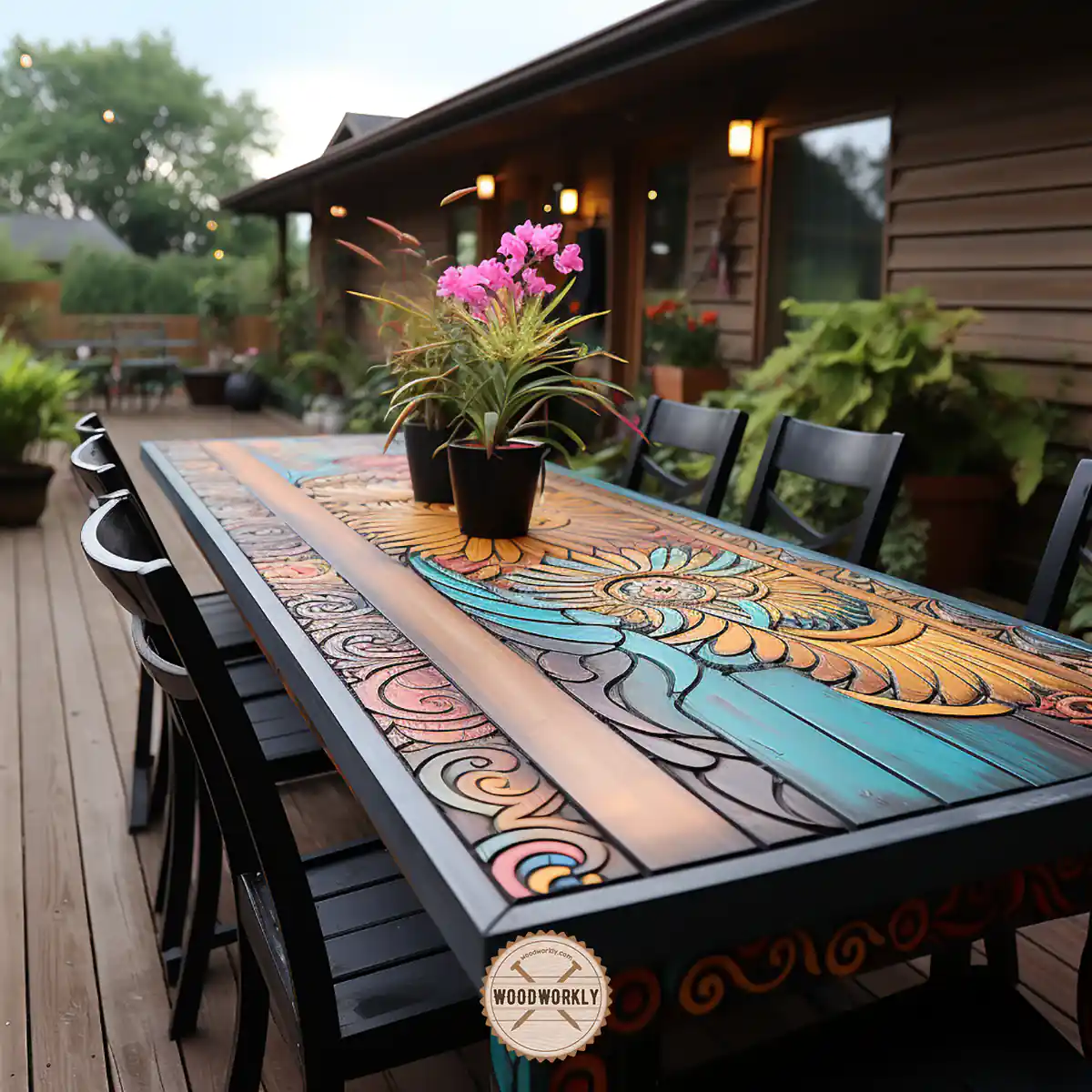
Why Do You Need To Seal Painted Wood?
You need to seal painted wood for extra protection because most commonly outdoor wood items need this extra protection to protect the wood from outdoor elements.
Because they are regularly subjected to heavy rain, heat damage, UV rays, long snow, high wear and tear etc.
Unless your garden furniture or deck isn’t protected by proper exterior paint, you will need to apply a sealant to gain extra protection and to ensure the longevity of your paint.
Furthermore, sealing is crucial for boat decks as they are continuously exposed to high moisture content and need to be more water resistant.
Some people apply sealer over paint as they want to change the gloss over the paint and also to gain an amber color or sepia tone appearance to the paint.
If you applied chalk paint or latex paint on outdoor furniture, it is acceptable to apply a sealer over the paint.
And if your furniture is subjected to high-traffic areas such as kitchen cabinets, and tabletops it is suitable to apply a sealer.
It may provide some benefits other than providing protection.
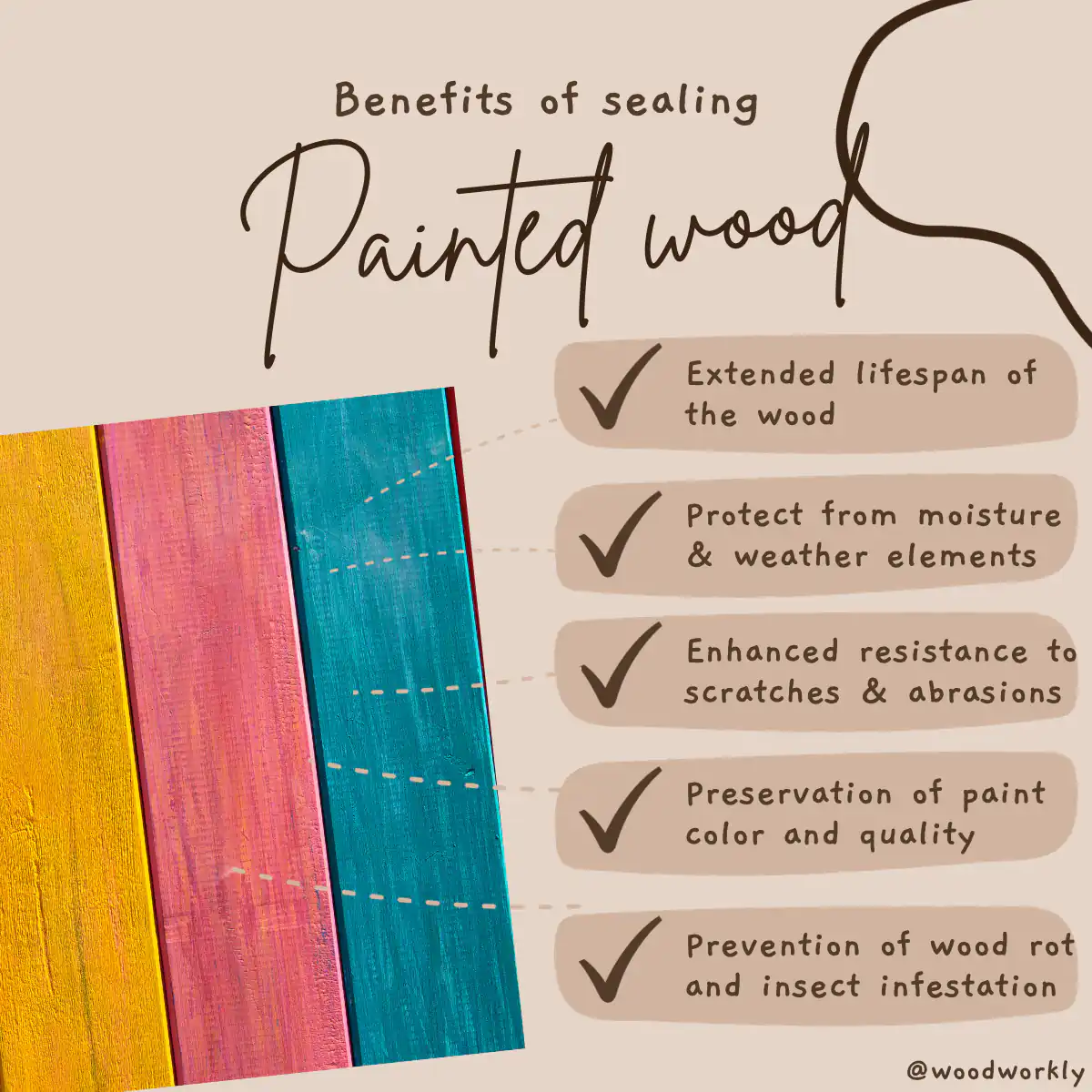
Advantages of Sealing Painted Wood for Outdoor Use
Here I’ve listed out all the pros and cons that I’ve gained by sealing painted wood.
Enhanced Durability
Sealing painted wood creates a protective layer that resists wear and tear, high foot traffic, heavy use, weathered conditions, etc.
This can greatly increase the lifespan of the paint as well as the underlying wood.
Enhanced Aesthetics
Sealing can give the painted surface an even finish, and a smooth touch by improving its overall appearance and giving it a polished and glossy appearance.
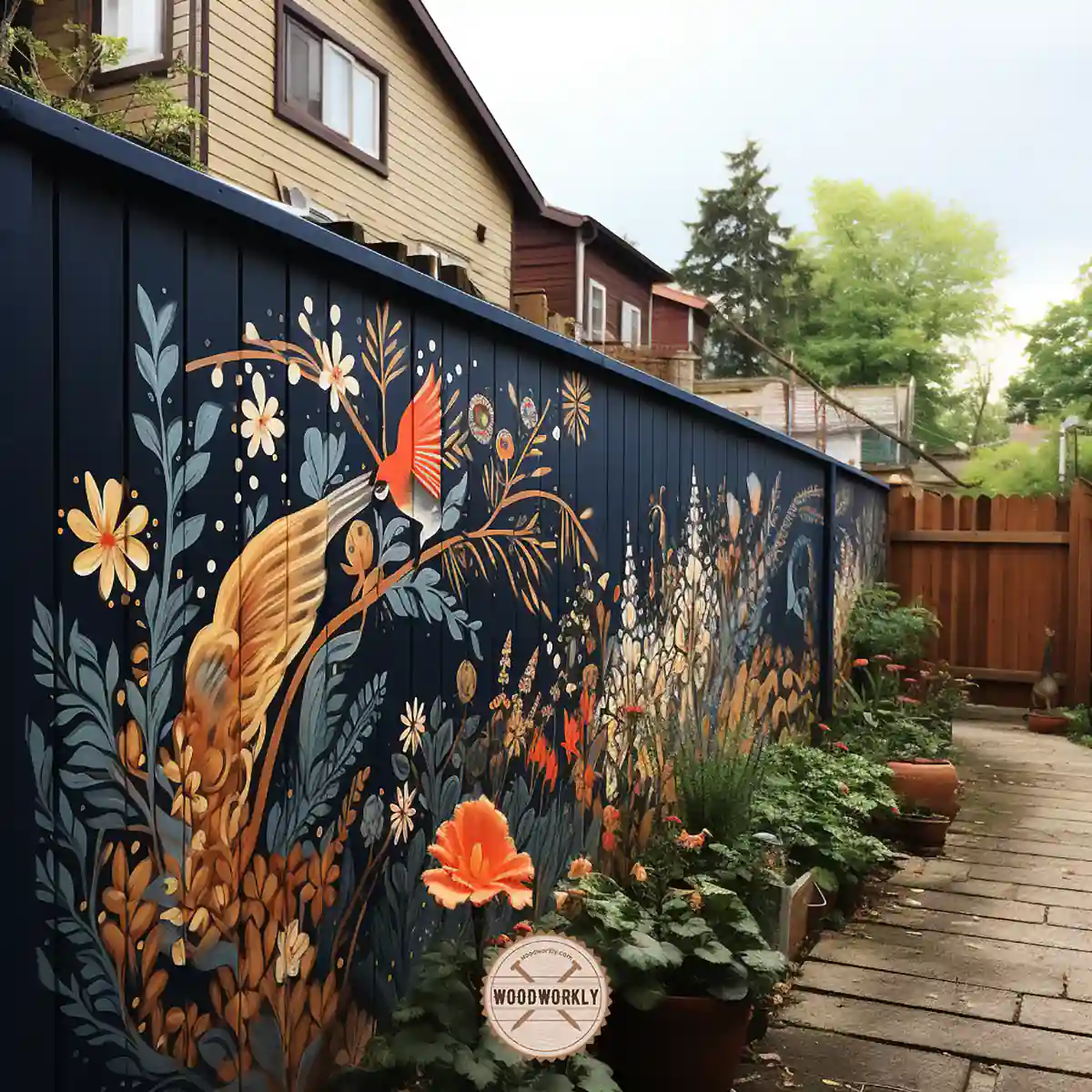
Protection against Moisture
Sealing acts as a barrier that prevents moisture from infiltrating the wood. This is especially important for outdoor applications since moisture can cause rotting, bending, and decay. This will prevent the paint from peeling or chipping off as well.
Weather Resistance
Sealing of outdoor wood surfaces like decks, fences, and furniture can survive weather conditions such as rain, snow, UV radiation, and temperature fluctuations.
Sealing can save your wood surface from shading when exposed to the sunlight. Exposing painted wood furniture to sunlight leads to photodegradation.
Here, UV radiation is absorbed by the pigments of the paint while breaking the bonds between paint particles.
Prevents Peeling and Cracking
Sealing your painted wood strengthens the bond between the paint and the wood and creates a flexible barrier.
This will keep the paint from flaking and chipping over time.
Frequent cracking is one of the common issues with unsealed furniture. By sealing you can significantly reduce this.
Improved Color Retention
Sealing can save your wooden furniture by reducing fading or subjecting discoloration caused by sunlight and weathering.
Resistance to Mildew and Mold
If your unsealed furniture is unsealed, there is a high probability of trapping spores of mold.
Some specially designed exterior sealants contain mildewcide chemicals to destroy spores of mold and mildew and to avoid them growing to keep the wood and paint clean and healthy.
Ease of Maintenance
It is easy to clean and maintain sealed painted woody items. You just wipe it off by using a damp cloth or hose it down as needed.
Simply this will give a fresh appearance.
Most sealants require reapplication after 1-3 years of first application. This depends on the type of sealer and the environmental conditions.

Factors You Need To Consider When Sealing Painted Wood For Outdoor Use
There are several things that you should especially consider before sealing painted wood for outdoor use.
Considering the below factors before finishing the wood helps you achieve a nice and durable seal.
Wood Type
The natural resistance of different wood species to rot and weathering is different. When choosing a sealer, consider the wood type and its inherent characteristics.
If your wood type is highly vulnerable to rots and weathering, you need to choose a strong protection.
Type of Paint
For the best results, choosing a compatible sealer for your painted wood is important.
Normally, oil-based paints are compatible with oil-based sealants while water-based paints are compatible with water-based sealants.
Sealer Type
There are different types of sealants available in the market. You need to choose the correct sealer that is compatible with the paint applied.
There are both color sealers and clear sealers. Clear sealers are less UV resistant comparatively.
UV Protection
As you want to choose a sealer for outdoor woods, select a sealer with UV resistivity since UV rays can fade the paint color eventually it will deteriorate over time.
The Degree of Protection Needed
If someone needs extra protection, you can apply a sealer with multiple coats.
Non-yellowing
Some sealers turn into amber-yellowish color over time (eg. oil-based polyurethane).
Proper application of sealers like water-based polyurethane and polycrylic sealers don’t change color.
So, You can choose a sealer to preserve the color and vibrancy of the painted surface.

Best Sealers For Painted Wood
Let’s talk about the types of sealer that best suit your outdoor furniture.
According to my experience, here are the best sealers for painted wood for outdoor use,
- Polyurethane
- Spray sealers
- Polyacrylic sealer
- Epoxy
- Tung oil
Let’s discuss them in detail to make your selection a lot easier.
Polyurethane
Polyurethane is a synthetic material that is widely used in any field including the woodworking industry due to its high versatility.
It is a strong sealer that most woodworkers are recommended to use. It can produce a clear, long-lasting polyurethane coat over your painted wood surface.
A proper layer on the surface can withstand extreme temperatures, moisture, corrosion sunlight, etc. It won’t be affected by mold and mildew and it isn’t rusty.
There are two types of polyurethane; water-based and oil-based polyurethane.
Oil-Based Polyurethane
Oil-based polyurethane produces a highly durable, long-lasting protective layer. Although this type can produce a sheen glossy finish, it tends to turn into a yellowish hue over time.
Therefore this type of poly is suitable for wood items painted in dark color.
This form of poly sealer contains a high amount of VOC with a strong bad smell.
These are toxic to our health. However, they are less expensive and require a longer time to dry than water-based poly.
Water-Based Polyurethane
Comparatively water based poly has less odor as it contains a lower amount of Volatile Organic Compounds (VOC) than oil-based poly.
Water-based poly can produce a colorless, clear coat that doesn’t change overtime. But this type is more expensive than oil-based poly
You can get the best results with acrylic and latex-painted woods and suitable for light-colored paints.
However, since it produces thin coats, for better protection you will need to apply multiple coats to get the same level of protection as it does with oil-based poly.
Polycrylic Sealer
Polycrylic sealers are very similar to water-based polyurethane. But not as durable as polyurethane.
This type forms a clear protective barrier over the painted wood, keeping it resistant to moisture, grime, abrasion, etc. It has a quick drying time, contains less VOC, and is therefore less toxic.
This type of sealant is very suitable for flat wood surfaces painted with water-based paints such as latex paints. But not compatible with oil-based paints because it is a water-based sealant.
No matter what you want; satin; clear or glossy finish, polycrylic will give it.
However, polycrylic and water-based polyurethanes are not well suited for external wood surfaces, because they may peel off when exposed to the weather.
Epoxy Sealer
This is also a suitable sealer type to preserve outdoor wood items. Since it can produce a hard, protective film with extreme water-repellent ability, it lasts a long time, about 5-10 years.
This is why these epoxy sealers are most popular among boatbuilders. Not only that, these types of sealers are available in both colored and colorless forms to produce a glossy finish.
Furthermore, it can mix with exterior varnish as well.
Wood Oils
Several naturally occurring oil types are used as outdoor wood item finishers. Among them, tung oil, coconut oil, linseed oil, and Danish oil are popular.
Exterior oils are popular because of their ability to enhance the natural beauty of wood while also offering long-lasting protection.
Tung oil produces a matte finish with excellent water resistance ability. Linseed oil can produce UV-resistant ability along with excellent penetration and moisture resistance ability.
Now, there are products with a combination of different natural oils with increased sealing activity.
Danish oil is a combined product of many oils and resins, including tung oil and linseed oil. It gives a glossy finish and provides moisture protection.
However, it may need to be reapplied on a regular basis.
Clear Acrylic Sealer
This produces solvent-borne single-pack clear acrylic coating which can be used for both indoor and outdoor items.
This is applied by using a sprayer. Multiple layers are applied to gain a super glossy appearance.
Paint and Sealer Combination Products
This is a new approach in the woodworking field. Combining both paint and sealer produces convenient and less time-consuming protection in a single application.
This type is also widely used in outdoor surfaces like decks, and fences to gain durable and long-lasting protection.
Most suitable for light-colored outdoor paints because this type produces a clear finish that is prone to discoloration.
This type has different protocols. Therefore, you need to be familiar with the manufacturer’s instructions before application.
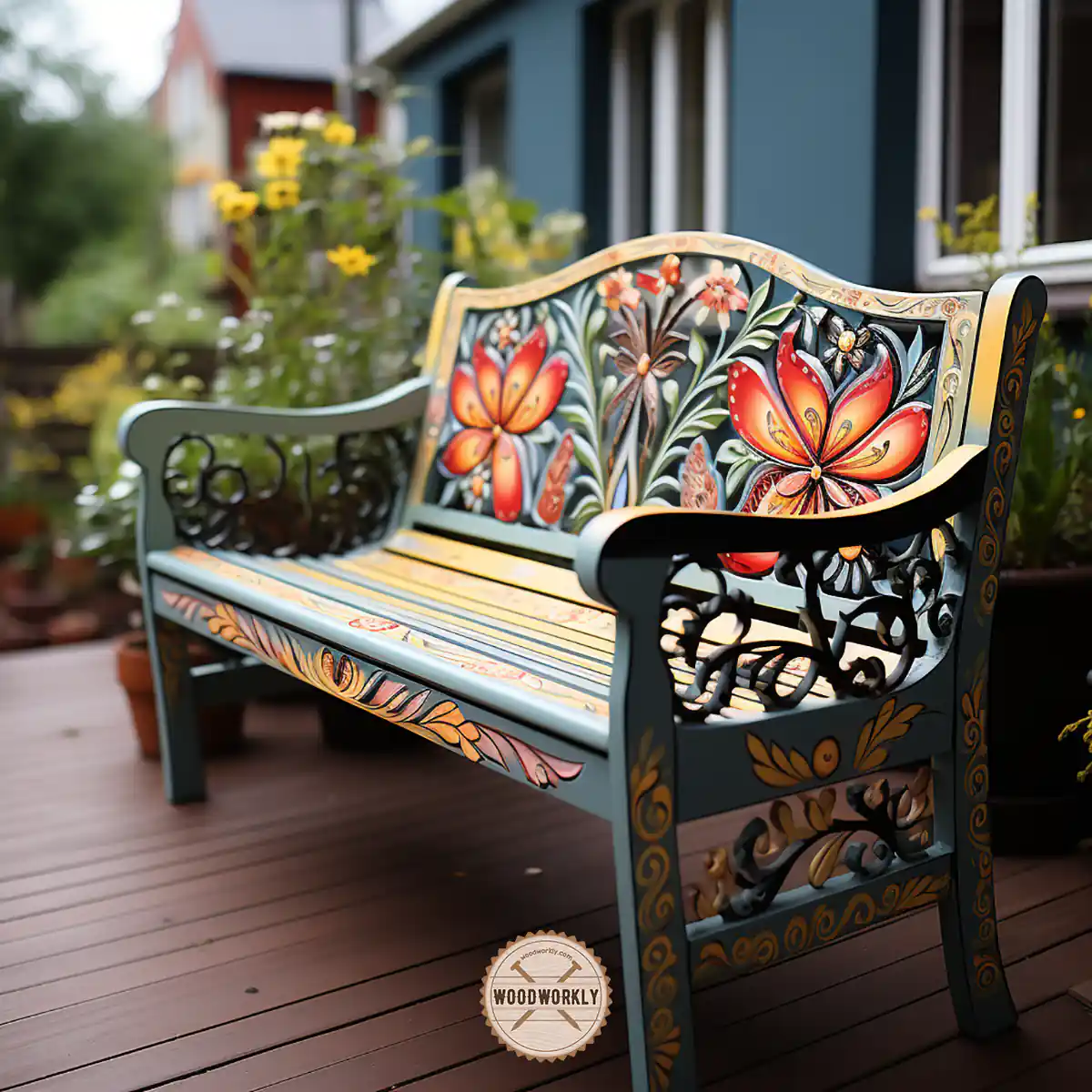
How To Seal Painted Wood For Outdoor Use
This is the most important part of the article. Here, I’ll explain the process of sealing painted wood for outdoor use.
Here are the steps you need to follow when sealing painted wood for outdoor use,
- Gather all the supplies you need
- Choose the correct sealant
- Prepare the painted wood surface
- Sand the surface
- Prep the sealant
- Apply the sealant
- Sand the cured sealant and reapply
- Let the surface to dry
Now, I’ll explain each step in detail. Just keep reading!
First, You need to strictly adhere to safety precautions. So, wear protective gloves, a mask, and goggles before starting the process.
If you use polyurethane as the sealant, you should be careful when handling such harmful chemicals.
1. Gather All the Supplies you Need
Before starting the process you need to gather all the materials and tools outlined below.
- Safety gear (goggles, gloves and a mask)
- Sandpaper
- Clean rags or a tack cloth
- The wood sealant that suits outdoor
- Quality paintbrush, roller, or sponge
- Trisodium phosphate (TSP)
Collect the above supplies from quality manufacturers to get a nice and smooth sealing coat during the process.
2. Choose the Correct Sealant
This is the most important step in this process.
Choose the best wood sealer for your furniture or project considering the wood type, the existing paint type, and the intended finish (clear or colored).
As an example, if you have applied polyacrylic or water-based paint, choose water-based sealant.
Furthermore, check that the sealer is suitable for outdoor usage and offers protection against moisture, UV, and environmental conditions.
3. Prepare the Painted Wood Surface
Make sure the painted wood surface is free of dirt and other contaminants. Otherwise, these will prevent bonding with sealant to the paint.
For the cleaning process, prepare a mixture of warm water and one-half cup of Trisodium Phosphate (TSP) in a cleaned bucket.
Soak a clean rag and squeeze out the rag until no water comes out.
Then, lightly wipe out the surface using a rag and completely dry the surface. This will take approximately one day.
4. Sand the Surface
Lightly sand the cleaned surface using sandpaper and remove all the dust particles using a tack cloth or a vacuum.
5. Prepare the Sealant
Gently stir the sealer using a clean stick to mix all the components to ensure uniform consistency.
6. Apply the Sealant
Gently soak the paintbrush and put it inside the can. But don’t wipe out excess liquid by touching the edge of the can to prevent air bubbling.
Apply a thin coat of sealant along the direction of the wood grain to avoid making mistakes and to gain an even and smooth finish.
You can apply the sealer by using a paintbrush roller or sprayer and allow it to dry completely. For this check with the manufacturer’s instructions, which is usually a few hours.
Make sure to apply a thin coat starting from one edge to the other edge along the direction of the wood grain in order to gain a uniform finish.
7. Sand the Cured Sealant and Reapply
Once the surface has dried use sand papers to lightly sand the surface to enhance better adhesion of the next coat.
Then reapply another coat and let it dry.
As needed, apply additional coats of sealer to obtain the desired level of protection.
Follow the manufacturer’s recommended drying time between coats.
8. Let the Surface to Dry
After the final coat, let the surface cure completely.
If you’ve selected a Water-based sealant or polyurethane, let it dry for about 2-3 hours between the coats and after the final coat.
But for oil-based sealants and polyurethane, let each coat dry for at least 24 hours before applying another.
For this follow the manufacturer’s instructions for a fast and efficient drying process.
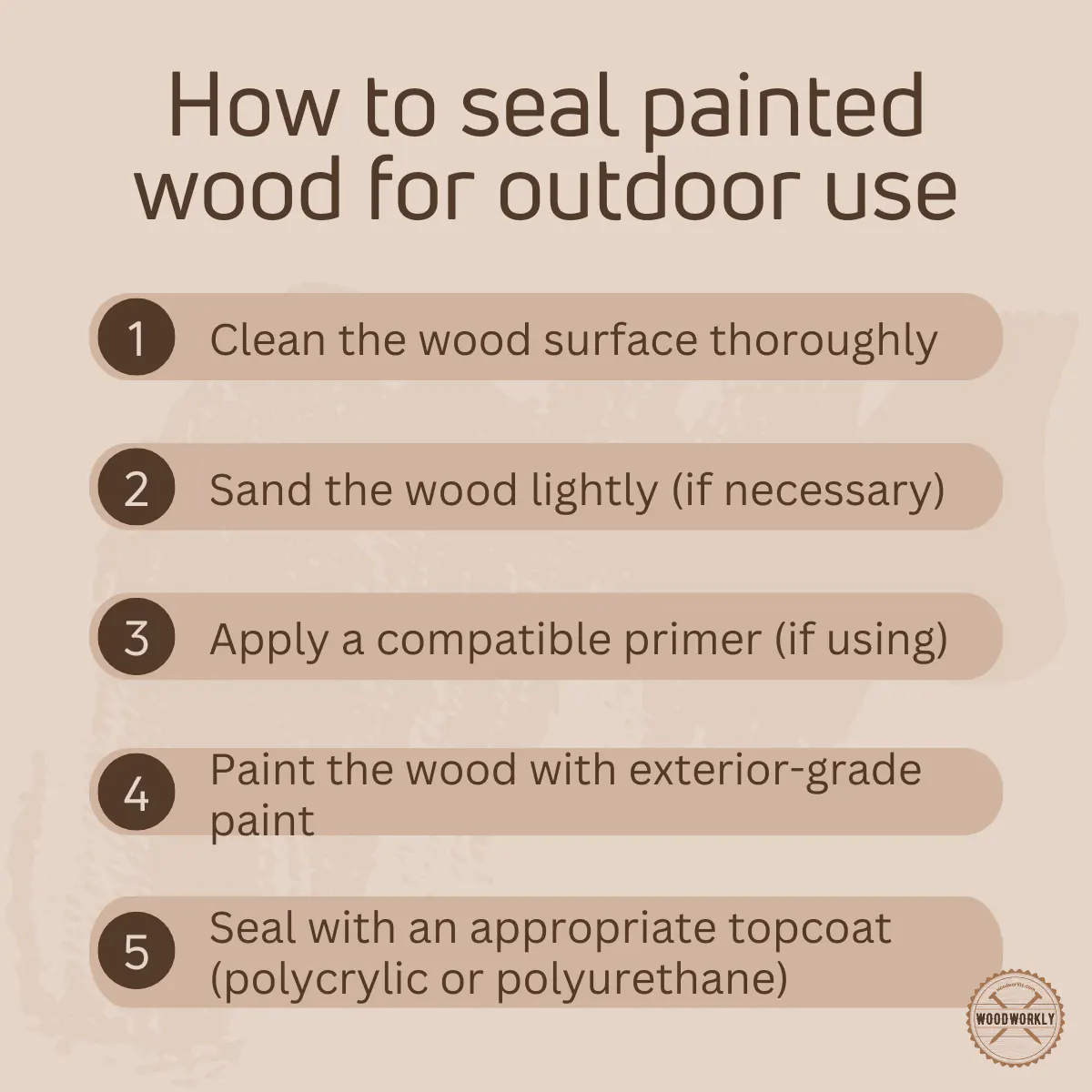
Tips for Sealing Painted Wood For Outdoor Use
Here are the tips and tricks that I have followed over the years when sealing painted wood for outdoor use for promising results.
- Before you begin the application process, make sure the surface is completely clean and dry. Because, if you wish to apply a clear sealer on colored paint, unseen dust and oils will prevent the sealant from adhering to the paint.
- To prevent bubbling, gently stir the sealer.
- Don’t brush exclusively as it also can introduce air bubbles.
- Before applying the sealer to the full surface area, test it on a small, inconspicuous area first to check whether it gives the desired finish or not.
Congrats folks! Now you know exactly how to seal painted wood for outdoor use using the right techniques.
So, let’s answer some frequently asked questions.
FAQs
What is the best sealer for painted wood for outdoor use?
Using a clear polyurethane topcoat can effectively seal exterior paints and prolong the life of the finish. The type of polyurethane (water-based or solvent-based) to be used depends on whether the paint is latex/acrylic or oil-based.
Can I use polycrylic to seal painted wood outdoors?
Yes, polycrylic can be used as a sealer for painted wood in outdoor settings, especially if you have used flat latex paint. However, it may not bond well with high-sheen paints or oil-based paints.
How should I prepare the wood surface before applying the sealer?
Before applying the sealer, make sure to clean the surface thoroughly to remove any dust and oils that might prevent the sealer from bonding well with the paint. The surface should be completely dry before starting the application process.
Is sealing the only method to protect painted wood for outdoor use?
No, sealing isn’t the only method. As an alternative, you can use a durable, waterproof acrylic enamel paint, which doesn’t require a topcoat sealer to protect it from abrasion and moisture.
What precautions should I take when choosing a sealer for oil-based paints?
When sealing oil-based paints, it is recommended to use a solvent-based polyurethane sealer to avoid potential flaking issues that can occur if you use a water-based sealer.
How can I protect an outdoor mural painted on wood?
To protect an outdoor mural painted on wood, ensure good substrate preparation, use quality paint, and seal the mural with an acrylic varnish that can provide protection without damaging the underlying mural.
Can I apply polycrylic on gloss paint?
Applying polycrylic on gloss paint is not recommended as the chemicals used to create the gloss within the paint might prevent the polycrylic from bonding permanently.
Did I cover all you wanted to know about: How To Seal Painted Wood For Outdoor Use?
In this article, I’ve explored how to seal painted wood for outdoor use by taking experts’ opinions and I’ve included my personal experiences as well.
Tips and techniques that are mentioned in the article will be super helpful to you to achieve the nice and durable result you’re looking for.
To seal painted wood for outdoor use first, you need to choose an appropriate sealant that is compatible with your painted wood, then clean and sand the painted surface lightly with sandpaper, gently stir the sealer, apply it, and allow the surface to dry. Apply multiple coats if you need a high level of protection.
Furthermore, I’ve answered some frequently asked questions as well.
Hope you learned everything you wanted to know about, how to seal painted wood surfaces for outdoor uses.
So, now give them a try and keep your loving outdoor furniture for decades with no issues!